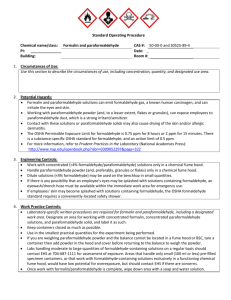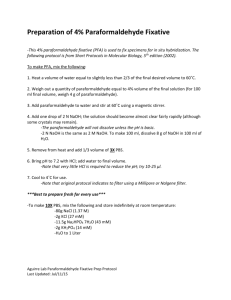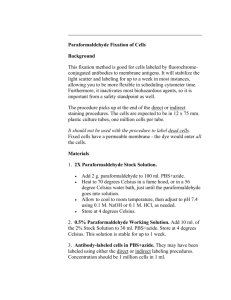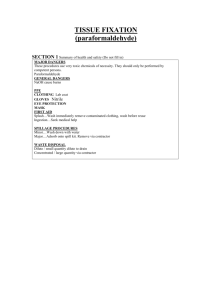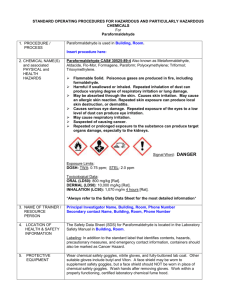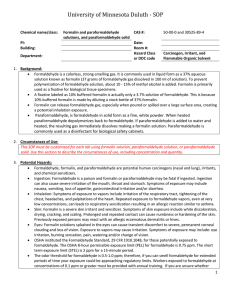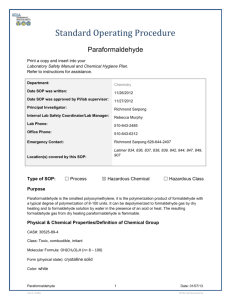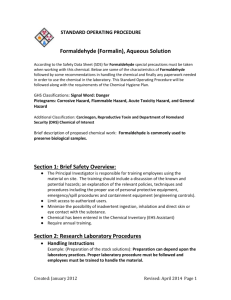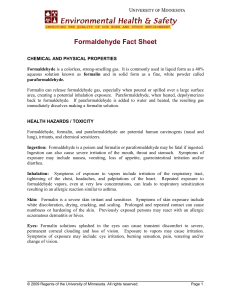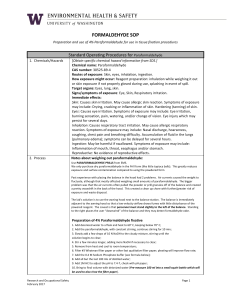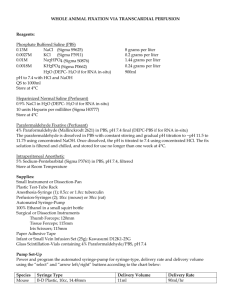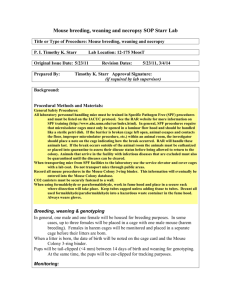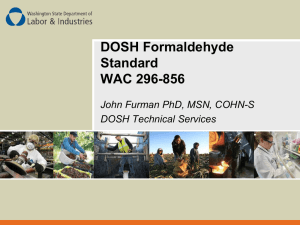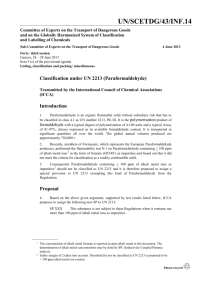Formalin
advertisement
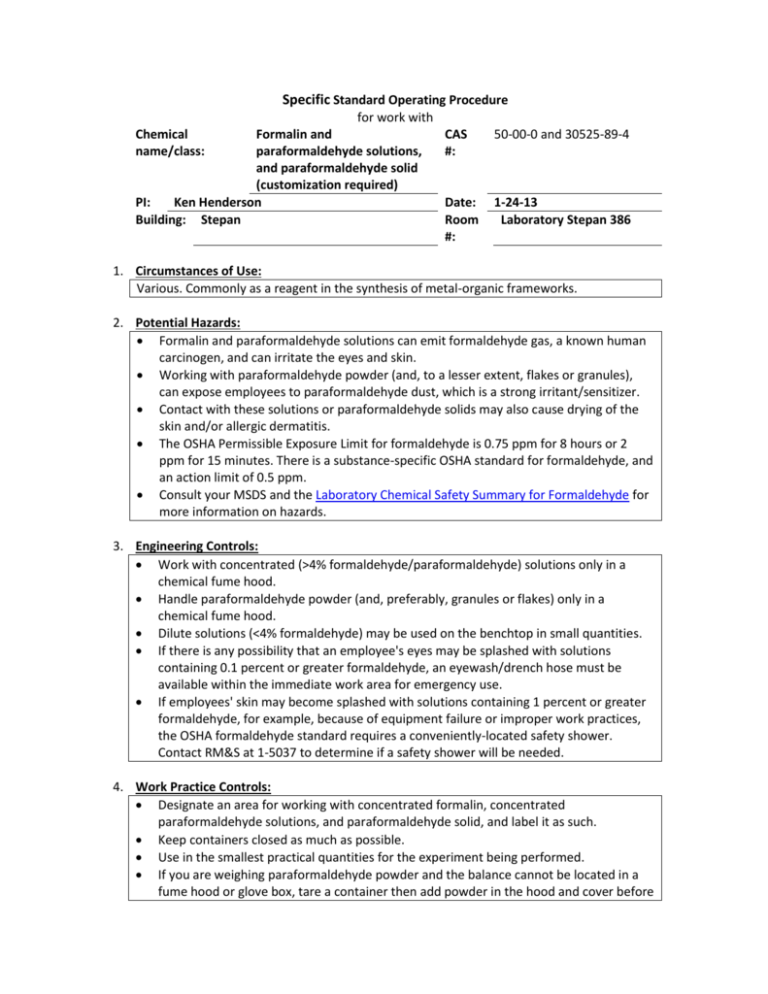
Specific Standard Operating Procedure for work with Formalin and paraformaldehyde solutions, and paraformaldehyde solid (customization required) PI: Ken Henderson Building: Stepan Chemical name/class: CAS #: 50-00-0 and 30525-89-4 Date: Room #: 1-24-13 Laboratory Stepan 386 1. Circumstances of Use: Various. Commonly as a reagent in the synthesis of metal-organic frameworks. 2. Potential Hazards: Formalin and paraformaldehyde solutions can emit formaldehyde gas, a known human carcinogen, and can irritate the eyes and skin. Working with paraformaldehyde powder (and, to a lesser extent, flakes or granules), can expose employees to paraformaldehyde dust, which is a strong irritant/sensitizer. Contact with these solutions or paraformaldehyde solids may also cause drying of the skin and/or allergic dermatitis. The OSHA Permissible Exposure Limit for formaldehyde is 0.75 ppm for 8 hours or 2 ppm for 15 minutes. There is a substance-specific OSHA standard for formaldehyde, and an action limit of 0.5 ppm. Consult your MSDS and the Laboratory Chemical Safety Summary for Formaldehyde for more information on hazards. 3. Engineering Controls: Work with concentrated (>4% formaldehyde/paraformaldehyde) solutions only in a chemical fume hood. Handle paraformaldehyde powder (and, preferably, granules or flakes) only in a chemical fume hood. Dilute solutions (<4% formaldehyde) may be used on the benchtop in small quantities. If there is any possibility that an employee's eyes may be splashed with solutions containing 0.1 percent or greater formaldehyde, an eyewash/drench hose must be available within the immediate work area for emergency use. If employees' skin may become splashed with solutions containing 1 percent or greater formaldehyde, for example, because of equipment failure or improper work practices, the OSHA formaldehyde standard requires a conveniently-located safety shower. Contact RM&S at 1-5037 to determine if a safety shower will be needed. 4. Work Practice Controls: Designate an area for working with concentrated formalin, concentrated paraformaldehyde solutions, and paraformaldehyde solid, and label it as such. Keep containers closed as much as possible. Use in the smallest practical quantities for the experiment being performed. If you are weighing paraformaldehyde powder and the balance cannot be located in a fume hood or glove box, tare a container then add powder in the hood and cover before returning to the balance to weigh the powder. Small (100 ml or less) pre-filled specimen containers, or work with formaldehydecontaining solutions exclusively in a functioning chemical fume hood, would have low potential for overexposure, but contact RM&S if there are concerns. Once work with formalin/paraformaldehyde is complete, wipe down area with a soap and water solution. 5. Personal protective equipment (PPE): Wear standard laboratory gloves, chemical splash goggles, face shield, and lab coat. If splash may occur, also wear an impervious apron. (OSHA requires that all contact of the eyes and skin with liquids containing 1 percent or more formaldehyde be prevented by the use of chemical protective clothing made of material impervious to formaldehyde and the use of other personal protective equipment, such as goggles and face shields, as appropriate to the operation.) 6. Transportation and Storage: Transport formaldehyde solutions in secondary containment, preferably a polyethylene or other non-reactive acid/solvent bottle carrier. Keep container in cool, well-ventilated area. Keep container tightly closed and sealed until ready for use. Store in secondary containment with flammables, away from oxidizers, reducing agents, metals, and acids. Keep containers of PFA solid away from water. Avoid storing on the floor. Avoid ignition sources. 7. Waste Disposal: Formalin and paraformaldehyde solutions and powders must be disposed of following the Chemical Hygiene plan. 8. Exposures/Unintended contact: Contact RM&S for medical advice on occupational chemical exposures, 1-5037. For an actual chemical exposure/injury Flush exposed eyes or skin with water for at least 15 minutes, then seek medical attention. If there is respiratory irritation associated with exposure, remove all persons from the contaminated area and contact the OESO spill team. Call 911 from a campus phone or 574-631-5555 from a cell phone to request assistance if needed. The work-related injury or illness report found at: http://chemistry.nd.edu/safety/supervisors-report-of-injury-to-the-health-center.pdf should be completed within 24 hours. If medical attention is needed, see http://chemistry.nd.edu/safety/procedures-for-injury-illness-or-incident.pdf. 9. Spill Procedure: Employees in the area should be prepared to clean up minor spills, including most spills confined to the chemical fume hood. Wearing double nitrile gloves, splash goggles, face shield and lab coat (and impermeable apron, if available), use absorbent pads to absorb spilled material. (For small spills of solid PFA, dampen the absorbent pad with methanol before placing over the spilled material and allow to sit for a few minutes before wiping up.) After spill has been completely absorbed, wash down contaminated area with soap and water at least two times. Contaminated PPE and clean-up materials must be placed in a clear plastic bag or compatible container for pick-up by RM&S. NOTE: If there is respiratory irritation associated with exposure, remove all persons from the contaminated area and contact the spill team at 911. Most spills of formalin or paraformaldehyde solutions, or paraformaldehyde powder that occur outside of a chemical fume hood should be referred to RMS by calling 1-5037 during working hours or 911 from a campus phone (574-631-5555 from a cell phone) after hours. 10. Training of personnel: All personnel are required to complete the General Lab Safety session thru RM&S. This session includes an introduction to general chemical safety. All personnel shall read and fully adhere to the laboratory-specific SOP for formalin, paraformaldehyde, and paraformaldehyde solutions, and shall document that they have read it by signing and dating the SOP.
